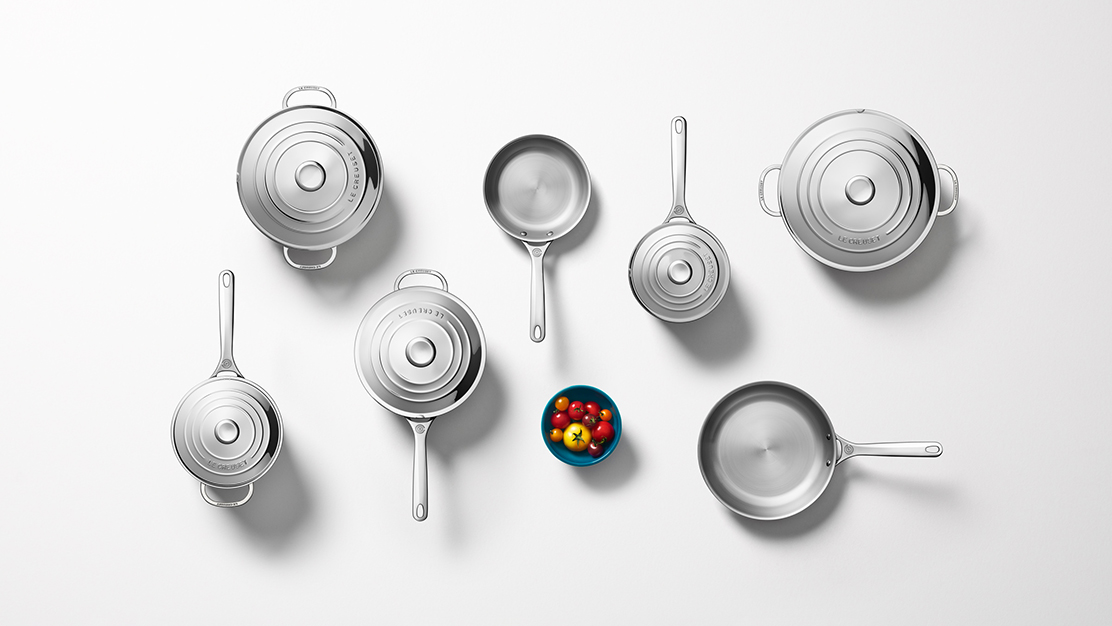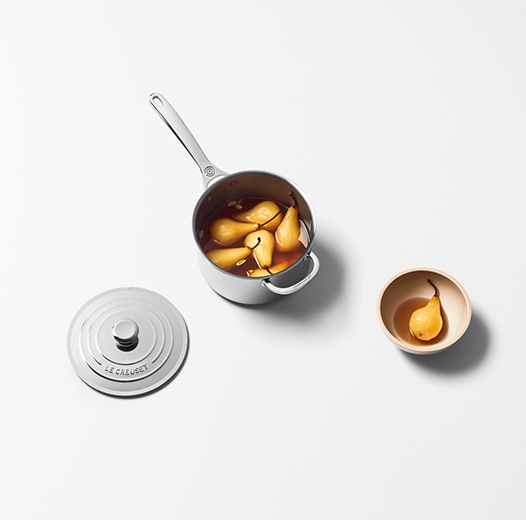
Professional and home chefs alike love using stainless steel cookware due to its versatility and ability to cook food evenly and quickly. Stainless steel cookware is extremely durable and is perfect for achieving a deep sear, blanching veggies or shallow frying. Taking the time to familiarize yourself with this premium material and how to best use it will make all the difference.
Le Creuset’s stainless steel cookware is crafted with quality materials, featuring a professional-grade triple layer construction. This includes an aluminum core bonded between two layers of premium stainless steel, ensuring its durability and ability to conduct heat more quickly. Le Creuset offers a variety of stainless steel products, ranging from sauciers, to stockpots and fry pans.
While stainless steel is built to last, it is important to keep in mind that it nonetheless comes with its own intricacies and pitfalls to avoid. From never bleaching it, to avoiding harsh cleaning agents, we have you covered.
Here are seven stainless steel cooking tips before you get started.
What is Stainless Steel Cookware?
Stainless cookware is one of the most popular types of cookware and accommodates a number of different cooking techniques, including searing, sautéing, browning, deep-frying, or boiling. This type of cookware is capable of withstanding high temperatures, making it ideal for searing meat, poultry, or fish. Stainless steel cookware sets typically include saucepans, frying pans, stockpots, rondeaus, and much more.
Stainless steel cookware is extremely versatile and can be used on any cooktop, including induction, electric, or gas, and is also safe for the oven. Le Creuset’s stainless steel cookware is made with premium materials, ensuring it can be used daily without the fear of scorching and eventually be passed on from generation to generation.
Its aluminum core is responsive to heat, exposing ingredients to a consistent heat source and cooking food evenly. Finally, a nonstick surface can easily be created on the surface of stainless steel cookware, once the pan is preheated appropriately and the oils and fats are added.
Our Tips
1. Pick the right cooking tools
One of the most important considerations to make when using stainless steel cookware is which kitchen utensils to use. Silicone cooking tools are typically recommended when using this type of material and will not harm the stainless steel surface. Alternatively, wooden or heat-resistant plastic tools can also be used.
Unlike with enamelled cast iron and toughened nonstick cookware, metal utensils, spoons, or balloon whisks could also be used on stainless steel. When using these tools, be extremely careful not to knock the top rim of the pan. This could compromise the aluminum core if repeated over many uses.
Finally, handheld tools, like an immersion blender could solely be used with stainless steel cookware. Using the appropriate tools may seem like a small detail, but will ultimately ensure your stainless steel cookware will last many uses.
2. Preheat the pan appropriately
Adding oil to a cold stainless steel pan is a recipe for disaster and will inevitably lead to food sticking to the surface as you cook, making cleanup a nightmare. Stainless steel, like many other metals, expands when it is heated and essentially seals all the pores of the surface. Taking the time to let the pan reach an appropriate temperature and fully preheat it will create a stick-resistant surface and simplify your cooking.
One of the best ways to ensure your stainless steel cookware is ready to be used is by conducting the water drop test. Once the pan is too hot to touch, introduce a droplet of water into it. If the droplet sizzles and hops around the pan, it is ready to be used.
Stainless steel cookware, initially, requires patience. Never preheat the pan on high temperature and spontaneously lower it. Extreme temperatures will warp the material and compromise the integrity of the stainless steel.
3. Don’t salt water before boiling
Do you intend on preparing delicious pasta dishes out of your stainless steel cookware set? Well, remember this one simple tip and you’re golden. Do not add salt to the water before it has reached boiling point. Salting the water in a stainless steel pot before the water is boiling can have damaging effects on your cookware and eventually lead to pitting.
Pitting causes irreversible damage to your stainless steel cookware and will greatly affect both its slick look and performance. These tiny bits of rust are, in fact, permanent, but luckily prevention is easy. Simply wait for the water to boil before adding any salt.
4. Avoid harsh cleaning agents
The next thing to consider when cleaning are the types of materials used. Avoid harsh cleaning agents and abrasive pads as they will damage the surface. In addition, steel and wool brushes should never be used to clean stainless steel cookware and will typically leave little particles on the surface. These particles will eventually rust, causing permanent damage to your cookware.
Steel brushes will also scratch the surface of the stainless steel, especially if used to scrub stubborn food residue. Nylon and soft abrasive pads are typically recommended to remove any remaining food residues and will maintain the integrity of the stainless steel for years to come.
5. Season your stainless steel cookware before making delicate dishes
Seasoning your stainless steel cookware is not required, but many chefs nonetheless do it. Seasoning will not only serve as a protective layer for the pan, but will also create an easy-release cooking surface, helping you prepare more delicate dishes. While preheating the pan appropriately should help avoid food from sticking, seasoning your cookware takes it one step further.
Seasoning cookware is an extremely easy process and involves baking oil into the stainless steel surface. Unlike with cast iron, however, seasoning stainless steel is not designed to continuously build up. With cast iron, a natural patina builds over time and improves with every use. Seasoning stainless steel, by contrast, is typically used temporarily and helps cook sensitive dishes.
6. Never bleach the stainless steel
Chlorine and bleaching agents may make your stainless steel cookware shine, but do more harm than good in the long run. These harsher products will eventually wear down the stainless steel and ruin the finish. Keep in mind when purchasing cleaning products that some will include trace amounts of bleach and chlorine. These products will harm the surface and over time, will trap contaminants into your cookware.
Le Creuset recommends a proprietary stainless steel cleaner to remove harsh stains, hard water lime scale, and other marks. These cleaning products could also be used to protect the inner and outer surfaces of your cookware. While stainless steel cookware is dishwasher safe, there is nothing better for this material than hand-washing it after each use.
7. Clean tough residue up as early as possible
This one is pretty straightforward, but that doesn’t make it any less important. As tempting as it may be to leave your stainless steel pan in the sink (and we’re all guilty of this) do not let grime, grease, or any other tough food residue sit in your stainless steel cookware for long periods of time. These will eventually leave stains on your pan that are both tough to remove and could harm the surface.
Removing tough stains will require scrubbing, which will damage the grain and reduce many of the benefits of this type of cookware. Stainless steel cookware is very durable and could withstand most spills and stains, however, it is still recommended to wipe up splatters as soon as they happen. Finally, never plunge a hot pan directly into water as thermal shock may occur, warping the base. Simply bring your stainless steel cookware to room temperature before rinsing it.
Cooking with Stainless Steel
Stainless steel cookware has established itself as a kitchen workhorse due to its versatility and ability to offer superior heat retention. This cookware is constructed with premium materials and is a great place to start your Le Creuset collection. From avoiding abrasive cleaning agents and never bleaching your stainless steel to learning how to preheat your cookware, these tips ensure you start your stainless steel adventure off on the right foot.
These were just seven of our favourite stainless steel cooking tips to help you get started in the kitchen, avoid common pitfalls, and most importantly, help you make the most out of your cookware for years to come. For more information, visit our care and use section on cooking with stainless steel cookware.


